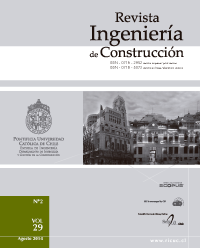Influence of water transportation inside a mortar/block system on bonding resistance behavior
DOI:
https://doi.org/10.4067/S0718-50732014000200004Keywords:
Mortar, rendering, transport, bond, propertiesAbstract
In the present study was performed an evaluation of the water transport in the mortar/block system, with the objective of linking the behavior of the bond strength by perpendicular tensile stress, and with water movement and porosity of mortar. This was done by producing two mortars with aggregates of different size distribution. Properties were determined in fresh state and bond strength was measured when hardened. The water transport profile was constructed by resistive sensors for measuring moisture. Measurements were done in different coats of mortars applied on a concrete substrate and the ceramic substrate. Masonry blocks used as a substrate were characterized according to their physical properties related to water absorption and porosity. The profile leads to the transport of water affects the porosity of mortar and showed that there is a direct relationship between the percentages of water being transported at different litters, with resistance to adhesion. Was checked also the not existence of relationship between the water retention test mortar and total water transported in the mortar-block system.


